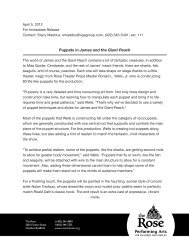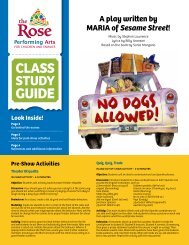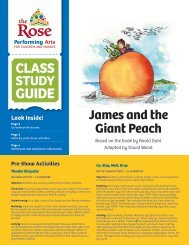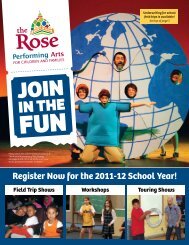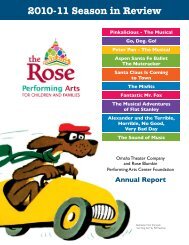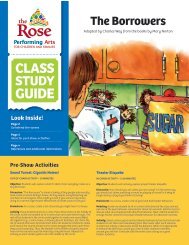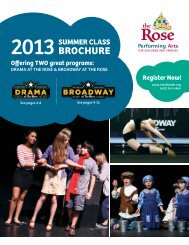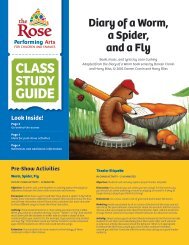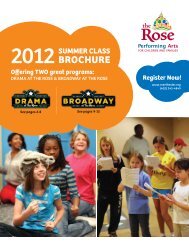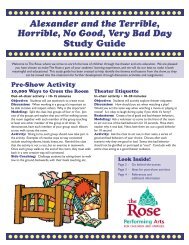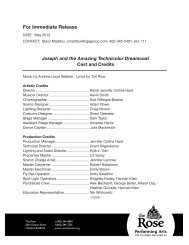The Adventures of Nate the Great - The Rose
The Adventures of Nate the Great - The Rose
The Adventures of Nate the Great - The Rose
Create successful ePaper yourself
Turn your PDF publications into a flip-book with our unique Google optimized e-Paper software.
Post-Show Activities<br />
Smartest Pet Contest<br />
IN-CHAIR ACTIVITY • 30-40 MINUTES<br />
Objective: Students will be able to use visual and performing arts<br />
toge<strong>the</strong>r to create <strong>the</strong>ir own Smartest Pet Contest.<br />
Discussion: What pets did <strong>the</strong> characters in “<strong>Nate</strong> <strong>the</strong> <strong>Great</strong>” have? What<br />
special talents did <strong>the</strong>ir smart pets showcase? What o<strong>the</strong>r pets can you<br />
have? Encourage students to think <strong>of</strong> pets people might not commonly<br />
have (like Oliver’s eel). What can a pet do to show that it is smart?<br />
Activity: Ask every student to choose one smart pet to create. Make<br />
your own sock puppet pet just like <strong>the</strong> ones in <strong>the</strong> show! Use an old sock<br />
and cut out felt, fun foam and fabric to add ears, paws, teeth, a tongue<br />
and more. You can glue on google eyes to finish your puppet. Encourage<br />
students to name <strong>the</strong>ir pet and to make additions that will show <strong>of</strong>f<br />
its intelligence.<br />
Extension: As a class, hold your own Smartest Pet Contest. Each student<br />
will get a chance to perform with <strong>the</strong> puppet he or she created. <strong>The</strong> class<br />
can also work toge<strong>the</strong>r to create a “Smartest Pet” prize.<br />
Make a Mystery to Solve<br />
OUT-OF-CHAIR ACTIVITY • 20-30 MINUTES<br />
Objective: Students will be able to use clues and reasoning to find objects.<br />
Discussion: How does a detective solve a mystery? What tools do<br />
detectives need to do <strong>the</strong>ir jobs? How do <strong>the</strong>y use <strong>the</strong>se tools?<br />
Preparation: Hide an object that is meaningful to <strong>the</strong> class somewhere in<br />
<strong>the</strong> school. Create clues and obstacles that will lead <strong>the</strong> students to <strong>the</strong><br />
hiding place.<br />
Activity: Tell <strong>the</strong> class that <strong>the</strong> object has gone missing. Ask students to<br />
look around <strong>the</strong> classroom to find clues. Working toge<strong>the</strong>r as a class, go<br />
on a scavenger hunt around <strong>the</strong> school that will eventually lead to <strong>the</strong><br />
final hiding place <strong>of</strong> <strong>the</strong> object. This can be especially fun if <strong>the</strong> faculty,<br />
staff, and even o<strong>the</strong>r students know about <strong>the</strong> hunt. <strong>The</strong>y can help give<br />
clues to your students.<br />
Create a Living Storybook<br />
OUT-OF-CHAIR ACTIVITY • 10 MINUTES<br />
Objective: To use imagination and bodies as acting tools, and also to<br />
review <strong>the</strong> play.<br />
Discussion: <strong>The</strong> actors used <strong>the</strong>ir bodies to create different scenes during<br />
<strong>the</strong> play. <strong>The</strong>y also used <strong>the</strong>ir imaginations to tell us a story. How can<br />
we use our bodies and imaginations to retell <strong>the</strong> story <strong>of</strong> “<strong>Nate</strong> <strong>the</strong> <strong>Great</strong>”?<br />
Remember, we’re going to have to work toge<strong>the</strong>r to tell this story.<br />
Activity: Review <strong>the</strong> story <strong>of</strong> “<strong>Nate</strong> <strong>the</strong> <strong>Great</strong>” with <strong>the</strong> students. Discuss<br />
how <strong>the</strong>y can break up <strong>the</strong> story into five parts. What happens in <strong>the</strong><br />
beginning? What next? How about <strong>the</strong> middle? After that? And how<br />
does <strong>the</strong> story end? Divide <strong>the</strong> class up into two groups. Tell <strong>the</strong>m <strong>the</strong>y<br />
are going to retell <strong>the</strong> story <strong>of</strong> “<strong>Nate</strong> <strong>the</strong> <strong>Great</strong> “with five frozen pictures,<br />
like a storybook. <strong>The</strong>y must decide which characters or set pieces <strong>the</strong>y<br />
are in each picture. Remember, <strong>the</strong> students don’t have to be <strong>the</strong> same<br />
characters in each picture. How can <strong>the</strong>y tell <strong>the</strong> story without moving<br />
or speaking? <strong>The</strong>n have <strong>the</strong> groups show <strong>the</strong>ir “storybooks” to each o<strong>the</strong>r.<br />
Have <strong>the</strong> group who plays <strong>the</strong> audience guess what is happening in each<br />
picture.<br />
Mmmm...Pancakes<br />
IN AND OUT-OF-CHAIR ACTIVITY •25-30 MINUTES<br />
Objective: Students will use <strong>the</strong>ir art and acting skills to create and<br />
experience tasting <strong>the</strong>ir own delicious, one-<strong>of</strong>-a-kind pancakes!<br />
Discussion: During <strong>the</strong> course <strong>of</strong> <strong>the</strong> play <strong>Nate</strong> constantly talked about<br />
and ate pancakes. Ask students to think about what type <strong>of</strong> pancake <strong>the</strong>y<br />
would like to create if <strong>the</strong>y could use any type <strong>of</strong> ingredient or topping <strong>the</strong>y<br />
wanted for it! First, think about your favorite kinds <strong>of</strong> dessert and breakfast<br />
ingredients and/or toppings. <strong>The</strong>n, toge<strong>the</strong>r make a list <strong>of</strong> <strong>the</strong>se ideas. Next,<br />
ask students to turn to a neighbor to discuss <strong>the</strong> ideas on <strong>the</strong> list, adding<br />
any o<strong>the</strong>r toppings or ingredients to <strong>the</strong> list that <strong>the</strong>y want. Finally, ask<br />
each student to create his/her own list and finalize what ingredients and<br />
toppings <strong>the</strong>y would like to have in <strong>the</strong>ir pancake creation.<br />
Activity: Tell <strong>the</strong>m to visualize what <strong>the</strong>ir pancake would look like. <strong>The</strong>n,<br />
have students use crayons and markers to draw <strong>the</strong>ir own unique pancake<br />
creation! Encourage students to think outside <strong>the</strong> box and be as creative<br />
and detailed as possible.<br />
Extension: Clear an area large enough in <strong>the</strong> room so that students can<br />
sit in a circle. One at a time, each student will get a turn to “take a bite” <strong>of</strong><br />
his/her pancake creation. Students will be using <strong>the</strong>ir imaginations and<br />
acting skills when doing this. <strong>The</strong> teacher should coach <strong>the</strong> students to<br />
take in <strong>the</strong> scrumptious smells <strong>of</strong> <strong>the</strong>ir pancake, and pretend as if <strong>the</strong>y are<br />
actually biting into and tasting <strong>the</strong>ir delicious pancake creation. <strong>The</strong>n, after<br />
<strong>the</strong> student has done so, he/she will describe <strong>the</strong> ingredients and toppings<br />
that are a part <strong>of</strong> <strong>the</strong>ir pancake creation to <strong>the</strong> rest <strong>of</strong> <strong>the</strong> class. <strong>The</strong> o<strong>the</strong>r<br />
students will <strong>the</strong>n take in <strong>the</strong> smells <strong>of</strong> <strong>the</strong> pancake, and pretend to “take<br />
a bite” <strong>of</strong> <strong>the</strong>ir fellow students’ pancake creation. Allow students to share<br />
how <strong>the</strong> pancake smelled and tasted. Each student in <strong>the</strong> circle will get a<br />
chance to share <strong>the</strong>ir pancake!<br />
Objects I Would Hate to Lose<br />
OUT-OF-CHAIR ACTIVITY • 10 MINUTES<br />
Objective: Students will think <strong>of</strong> an important object that means a lot to<br />
<strong>the</strong>m. <strong>The</strong>n, <strong>the</strong>y will use <strong>the</strong>ir acting skills to pantomime using that object<br />
and have o<strong>the</strong>r students guess what it is.<br />
Vocabulary: Pantomime – When someone uses gestures or expressions<br />
without speech to convey a message.<br />
Discussion: As a class, recollect how during <strong>the</strong> course <strong>of</strong> <strong>the</strong> play, many<br />
characters lost objects that were important to <strong>the</strong>m, which is why <strong>the</strong>y<br />
had to ask <strong>Nate</strong> to find <strong>the</strong>m. Ask students: How would you feel if you lost<br />
something really important or valuable to you? What might you do to<br />
find it? Ask students to think about an important object that means a lot<br />
to <strong>the</strong>m. It can be a keepsake, a family heirloom, or perhaps a favorite toy,<br />
article <strong>of</strong> clothing, or favorite video game or movie.<br />
Activity: Clear an area large enough in <strong>the</strong> room so that students can sit<br />
in a circle. One at a time, each student will get a turn to pantomime using<br />
<strong>the</strong> object <strong>the</strong>y have thought <strong>of</strong>. Students use <strong>the</strong>ir body language and<br />
gestures as well as <strong>the</strong>ir imaginations to pretend as if <strong>the</strong>y are actually<br />
using this object. Once student is done pantomiming <strong>the</strong>ir object, let o<strong>the</strong>r<br />
students in <strong>the</strong> circle guess what <strong>the</strong> object was. Each student in <strong>the</strong> circle<br />
will get a chance to share his or her keepsake object.<br />
Sidecoaching: Which characters should be in this picture? Which set<br />
pieces should we show? How can you show with your body which<br />
character you’re playing? What positions can we freeze in to show what is<br />
happening?<br />
STUDY GUIDE 3



